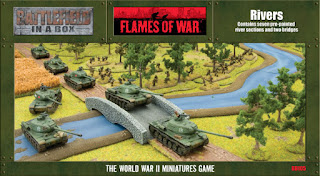One of the main scenarios in SAGA involves crossing a river with two bridges/fords, and my collection was lacking a river which meant I wasn't able to host this scenario. I looked at several of the commercially available options:
The Pegasus Hobbies river: I don't like the paintjob, it's probably a little narrow, and is also too short (I need a 4' river). Not a bad product though, if you're looking for a quick and easy way to toss a river on your table, and very hard wearing.
The Amera river: Not a bad product at all, and I was extremely tempted by this one! However, being that it is vacuum formed plastic means there is a fair bit of work involved in getting it ready for the table top. You need to cut a base board to size and glue the river down, then trim the edges, sand the whole thing so it will take a coat of glue/paint, then texture and paint it, etc. Frankly, I think there's just as much work involved in making your own river from scratch.
Flat rivers: There are a variety of flat rivers available printed on neoprene sheets that you just lay on your table. Obviously the images are very nice and the river just rolls out where ever you need it, but they're also two dimensional with no depth and that's a deal breaker for me. Have you ever seen pictures of Warmachine tables using nothing but 2D printed terrain? It's just sad.
The GF9 river: Much the same as the pegasus hobbies river, I avoided this one for the same reasons. A very nice product though, and one I was sorely tempted by.
In the end, I decided to build my own. I was being quite fussy about the width and the shape of the banks, so rather than buy something and spend ages trying to adjust it, I decided to just make my own.
I bought a 900 x 1200 x 3 MDF board, and drew a large river on in, between 6" and 7" wide. I cut it out using a handheld coping saw, then used a dremel with a sanding attachment to bevel the edges.
I bought some acrylic builders caulk (it's important to use acrylic! Silicone is NOT suitable for modelling purposes!) to make the banks with. I put two or three layers down, letting each one set before I did the next, and smoothing them out as I went with a spatula and a wet sponge. I would lay a thick sausage entirely along one bank, smooth it to shape with the spatula, and let it dry a bit. Then I would add the second layer, blend it into the first, and use the damp (not dripping) sponge to smooth out some of the bumps and ridges. You really need to let the caulk set for a two or three days before you sand it. This is the first time I've used this material, and it's great stuff, easy to work with and dries hard. And if you buy an earthy brown one like I did, then it's very forgiving when it comes to painting.
For the water itself I considered several options. There's the resin option, the acrylic artists gel option, varnish, and plain old paint. I discounted the resin due to the size of the project, and after looking at several on-line tutorials I decided I liked the look of the artists gel the most. Unfortunately, the product I used (Derivan artists medium gel) didn't perform quite the way it was advertised. The container said any depth less than 3mm would dry clear. False. While some patches did dry clear, they were MUCH thinner than 3mm. Anything over about 1.5mm stayed cloudy to one degree or another. Also, during the curing process the product develops tiny air-bubbles inside it. Probably not noticeable on a smaller project like a thinner river or a fountain, but for a large 6" wide river it was quite noticeable.
Luckily, the supplies I had bought for the first attempt were more than enough for a second attempt. I decided this time I'm going to try varnish. Resin is the other option but in the amount I'd need it's quite expensive and it would be an unknown entity. I don't know if it will react to the paints I'm using, how much it would shrink, if the shrinkage would warp the MDF I'm using as a base, and at the end of it all you get a gloss mirror finish which isn't very river-like. So I decided to use varnish. Again the width of the river presented some problems, because on such a wide surface any brush-strokes would be very visible. So I opted for a can of spray varnish, and put down several coats. In the end, this didn't provide quite as much coverage as I had wanted, but I can always go back and apply some varnish with a brush, before coating it with spray varnish again to even the texture out.
First I undercoated the entire project in black. Then I sprayed the river a dark green, leaving the centre of the river black the darkest to simulate depth. Then I airbrushed a sandy brown colour on the edges to simulate sandy/earthy shores. At this stage the river looks like this:
Then I followed the same basing technique I use for everything: Paint the shores (which were covered in sand to provide texture prior to commencing any painting) in dark brown, drybrush in light brown, then bone. Then apply static grass, leaving patches of earth showing through, before applying foliage, tufts and flowers/weeds. I used tufts from Gamer's Grass which I am really happy with. I've been using these tufts for basing models and terrain for a little while now and have no complaints at all.
Here you can see the finished product, a small village nestled against the banks of the river:
































